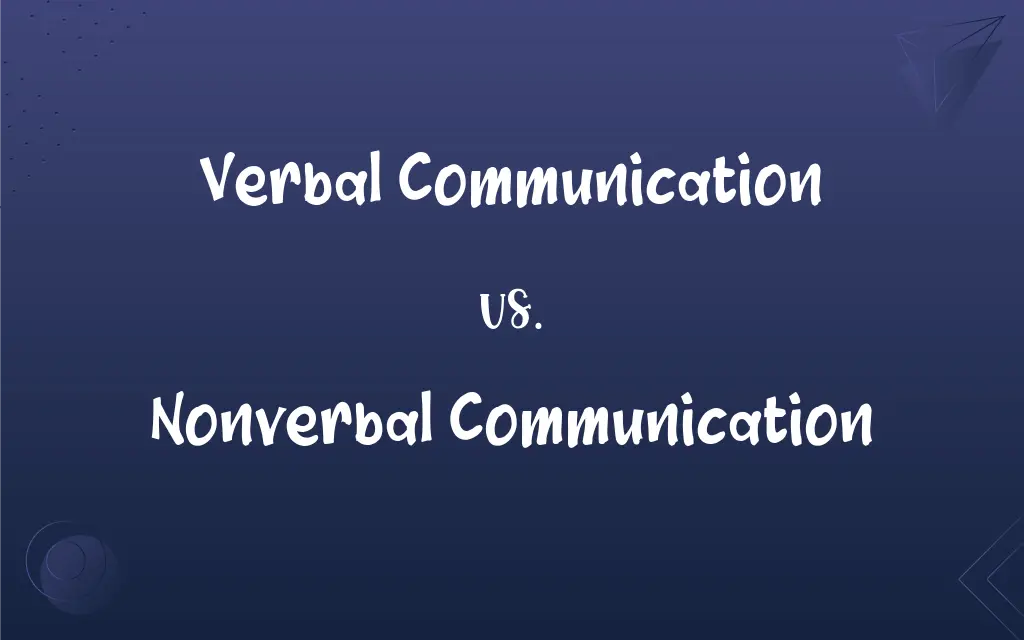Verbal Communication vs. Nonverbal Communication: What's the Difference?
Edited by Janet White || By Harlon Moss || Updated on October 3, 2023
Verbal communication involves spoken or written words, while nonverbal communication relies on gestures, body language, and other unspoken signals.

Key Differences
Verbal communication, as the term suggests, encompasses the use of words, whether spoken or written, to convey messages. It's direct and often explicit, allowing for detailed exchange of information. Nonverbal communication, on the other hand, is more about understanding the implicit cues and silent messages sent via gestures, facial expressions, and body language.
In many interactions, verbal communication serves as the primary mode of expressing thoughts, ideas, and feelings. It follows linguistic rules and can be easily documented. Nonverbal communication, conversely, can be more ambiguous and relies heavily on the cultural, contextual, and personal interpretation of those involved in the conversation.
While verbal communication can be clear-cut, it might sometimes fall short in conveying emotions and feelings. Nonverbal communication fills this gap effectively. For instance, a person's tone of voice in verbal communication can be complemented with facial expressions in nonverbal communication to give a complete picture of their emotional state.
Both forms of communication are vital in daily interactions. Verbal communication is often the first mode people resort to, especially in formal settings. However, nonverbal communication provides depth and can often convey messages that words can't, making it equally essential.
Comparison Chart
Mode
Spoken or written words
Gestures, body language, facial expressions
ADVERTISEMENT
Clarity
Often explicit
Can be ambiguous
Documentation
Easily documented
Hard to document
Cultural Variance
Less variation (within same language)
High variation across cultures
Usage in Conversation
Primary mode in formal settings
Provides depth, emotions, and emphasis
Verbal Communication and Nonverbal Communication Definitions
Verbal Communication
Conveyance of messages through spoken or written language.
His verbal communication skills were apparent in his eloquent emails.
ADVERTISEMENT
Nonverbal Communication
Communication through body gestures and facial expressions.
His raised eyebrow was a form of nonverbal communication indicating disbelief.
Verbal Communication
Transmission of thoughts via linguistic means.
The team prioritized clear verbal communication during meetings.
Nonverbal Communication
Expression through non-linguistic means.
The hug was a powerful form of nonverbal communication, showing comfort and support.
Verbal Communication
The exchange of information using words.
She excelled in verbal communication, making her an effective presenter.
Nonverbal Communication
Relaying messages without the use of words.
She used nonverbal communication, like a nod, to show her agreement.
Verbal Communication
Expression of emotions and data through words.
The seminar focused on enhancing verbal communication among peers.
Nonverbal Communication
Conveyance of feelings without speech or writing.
Her eye contact was a form of nonverbal communication emphasizing her sincerity.
Verbal Communication
Sharing ideas using structured language.
Verbal communication training helped him in his public speaking endeavors.
Nonverbal Communication
Sharing information via implicit cues.
His posture during the interview was a nonverbal communication of confidence.
FAQs
How does nonverbal communication differ from verbal?
Nonverbal communication uses gestures, facial expressions, and body language, whereas verbal uses words.
Why is it important to be aware of one's own nonverbal cues?
To ensure they align with the intended message and don't inadvertently mislead or offend.
Is sign language considered verbal or nonverbal communication?
Though it uses hand gestures, sign language is structured like a verbal language, so it's a form of verbal communication.
What comprises verbal communication?
Verbal communication involves exchanging messages through spoken or written words.
Why is nonverbal communication important in conversations?
It provides emotional context, emphasis, and can sometimes convey messages words can't.
How can tone of voice impact verbal communication?
Tone can add emotional context, change meaning, and either enhance or detract from the message.
How does physical distance influence nonverbal communication?
It can indicate intimacy, neutrality, or even hostility, based on cultural and individual preferences.
Are facial expressions a reliable form of nonverbal communication?
Generally, but they can be controlled or misread, so context is essential.
In what scenario is verbal communication preferable to nonverbal?
In detailed instructions, legal matters, or when clarity and documentation are required.
Can nonverbal cues contradict verbal messages?
Yes, such as when someone says they're fine but their body language suggests otherwise.
Can a silence be a form of nonverbal communication?
Absolutely, silence can convey thoughtfulness, discomfort, agreement, or even dissent, depending on context.
Can verbal communication be ambiguous like nonverbal communication?
Yes, if words are vague or the context is unclear, verbal communication can be ambiguous.
Can nonverbal communication be intentional or unintentional?
Yes, it can be both; a deliberate thumbs-up or an unintentional grimace are examples.
What role does eye contact play in nonverbal communication?
It can indicate interest, sincerity, or even aggression, depending on the context.
Can verbal communication be non-linear?
Yes, conversations can jump between topics, especially in informal settings.
Is written verbal communication less effective than spoken?
Not necessarily, but it lacks vocal tone and requires clarity to avoid misunderstandings.
How do cultural norms impact verbal communication?
They influence language structure, etiquette, and even topics considered appropriate for discussion.
Can verbal communication be in written form?
Yes, verbal communication can be both spoken and written.
How can one improve their nonverbal communication skills?
By being observant, practicing active listening, and seeking feedback on one's own nonverbal cues.
Why is understanding cultural differences vital in nonverbal communication?
Because nonverbal cues vary across cultures and can lead to misunderstandings if misinterpreted.
About Author
Written by
Harlon MossHarlon is a seasoned quality moderator and accomplished content writer for Difference Wiki. An alumnus of the prestigious University of California, he earned his degree in Computer Science. Leveraging his academic background, Harlon brings a meticulous and informed perspective to his work, ensuring content accuracy and excellence.
Edited by
Janet WhiteJanet White has been an esteemed writer and blogger for Difference Wiki. Holding a Master's degree in Science and Medical Journalism from the prestigious Boston University, she has consistently demonstrated her expertise and passion for her field. When she's not immersed in her work, Janet relishes her time exercising, delving into a good book, and cherishing moments with friends and family.






































































